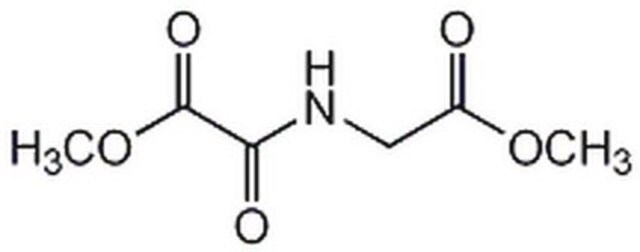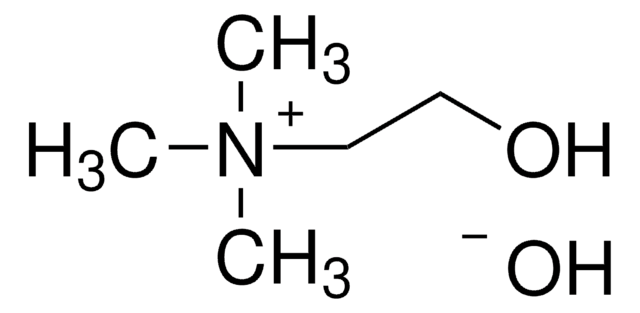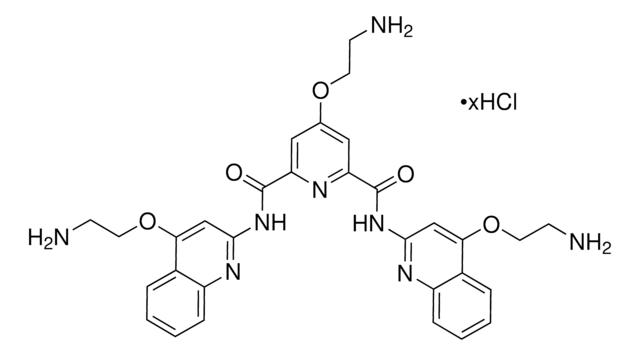おすすめの製品
アッセイ
≥98% (HPLC)
形状
powder
色
white to beige
溶解性
DMSO: 2 mg/mL, clear (warmed)
保管温度
2-8°C
SMILES記法
OC(C1=C(N2CCC3CC3)C=CC(F)=C1)=C(C(NCC(O)=O)=O)C2=O
InChI
1S/C17H17FN2O5/c18-10-3-4-12-11(7-10)15(23)14(16(24)19-8-13(21)22)17(25)20(12)6-5-9-1-2-9/h3-4,7,9,23H,1-2,5-6,8H2,(H,19,24)(H,21,22)
InChI Key
TYHRZQVUPPODPT-UHFFFAOYSA-N
生物化学的/生理学的作用
GSK360A (GSK1120360A) is an orally active HIF-prolyl 4-hydroxylase (HIF-PHD) inhibitor that targets all three HIF-PHD isoforms (PHD1 > PHD2 = PHD3) with high potency (IC50 from 10-120 nM) in a 2-oxoglutarate (2-OG)-competitive manner. GSK360A promotes cardiomyocyte mitochondrial aerobic glycolysis under normoxic conditions by stabilizing cellular hypoxia-inducible factor-1 (HIF-1) and thereby upregulating HIF-1α target genes transcription (50 μM for 8 hrs in murine cardiomyocyte HL-1 cultures), including pyruvate dehydrogenase kinase-1 (PDK1) and hexokinase II (HKII). GSK360A treatment is shown to protect against acute myocardial ischemia–reperfusion injury (IRI) both in cultures and in rats in vivo (30 mg/kg p.o.) by reducing mitochondrial permeability transition pore (MPTP) opening and oxidative stress during IRI.
保管分類コード
11 - Combustible Solids
WGK
WGK 3
引火点(°F)
Not applicable
引火点(℃)
Not applicable
適用法令
試験研究用途を考慮した関連法令を主に挙げております。化学物質以外については、一部の情報のみ提供しています。 製品を安全かつ合法的に使用することは、使用者の義務です。最新情報により修正される場合があります。WEBの反映には時間を要することがあるため、適宜SDSをご参照ください。
Jan Code
SML2175-5MG:
SML2175-25MG:
SML2175-VAR:
SML2175-BULK:
試験成績書(COA)
製品のロット番号・バッチ番号を入力して、試験成績書(COA) を検索できます。ロット番号・バッチ番号は、製品ラベルに「Lot」または「Batch」に続いて記載されています。
J P Gumucio et al.
Bone & joint research, 6(1), 57-65 (2017-01-22)
Rotator cuff tears are among the most frequent upper extremity injuries. Current treatment strategies do not address the poor quality of the muscle and tendon following chronic rotator cuff tears. Hypoxia-inducible factor-1 alpha (HIF-1α) is a transcription factor that activates
Sang-Ging Ong et al.
Cardiovascular research, 104(1), 24-36 (2014-07-30)
Hypoxia-inducible factor-1 (HIF-1) has been reported to promote tolerance against acute myocardial ischaemia-reperfusion injury (IRI). However, the mechanism through which HIF-1 stabilization actually confers this cardioprotection is not clear. We investigated whether HIF-1α stabilization protects the heart against acute IRI
Jin Zhou et al.
PloS one, 12(9), e0184049-e0184049 (2017-09-08)
There is interest in pharmacologic preconditioning for end-organ protection by targeting the HIF system. This can be accomplished by inhibition of prolyl 4-hydroxylase (PHD). GSK360A is an orally active PHD inhibitor that has been previously shown to protect the failing
Weike Bao et al.
Journal of cardiovascular pharmacology, 56(2), 147-155 (2010-08-18)
Hypoxia inducible factors (HIFs) are transcription factors that are regulated by HIF-prolyl 4-hydroxylases (PHDs) in response to changes in oxygen tension. Once activated, HIFs play an important role in angiogenesis, erythropoiesis, proliferation, cell survival, inflammation, and energy metabolism. We hypothesized
Tomohiro Suhara et al.
Proceedings of the National Academy of Sciences of the United States of America, 112(37), 11642-11647 (2015-09-02)
Loss of prolyl hydroxylase 2 (PHD2) activates the hypoxia-inducible factor-dependent hypoxic response, including anaerobic glycolysis, which causes large amounts of lactate to be released from cells into the circulation. We found that Phd2-null mouse embryonic fibroblasts (MEFs) produced more lactate
ライフサイエンス、有機合成、材料科学、クロマトグラフィー、分析など、あらゆる分野の研究に経験のあるメンバーがおります。.
製品に関するお問い合わせはこちら(テクニカルサービス)








